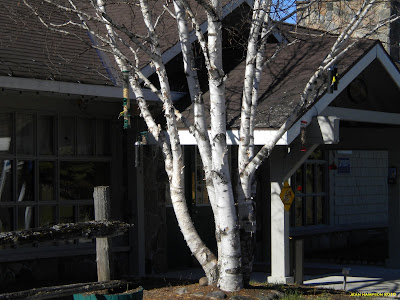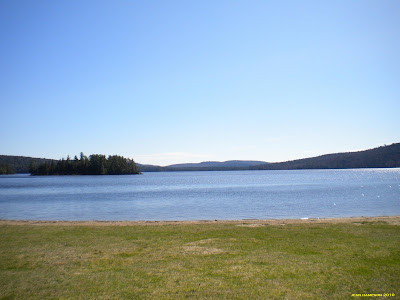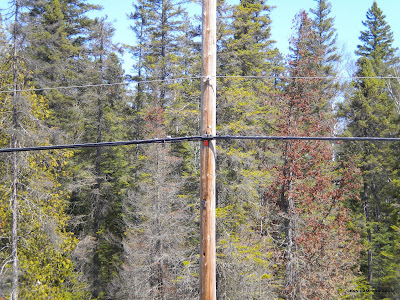April 19
The day after the
OFO Algonquin trip, Jean and I returned to
Algonquin Provincial Park for another day of birding. We had the week off so there was no need to rush home.
Thanks to worthwhile tip provided by Ron Tozer during Sunday's field trip, Jean and I would make a stop near
Oxtongue Lake before entering the provincial park. Ron informed me that the lifer bird Jean and I sought was producing reliable views at the feeders on the property of the Algonquin Inn.
We arrived at the front entrance to the inn around 9:00 AM. The restaurant was closed but the activity around the large number of feeders was buzzing. We saw no sign of the owners so Jean and I stood in the front parking lot taking in the views of the birds as they visited the nearby feeders.
 American Goldfinch
American Goldfinch,
Dark-eyed Junco, Purple Finch and
Black-capped Chickadee were observed.

Within minutes of arriving we spotted our first lifer of 2010. I was positive I observed a male of the species fly across Highway 60 and disappear into a stand of conifers. Sure enough, I was not seeing things. Three Evening Grosbeaks (2 males and 1 female) were found in a birch tree on the east side of the restaurant. We had some great views despite them being uncooperative for a digiscoped image.

The owner of the Algonquin Inn returned from birding in the park and allowed Jean and access to the back of the property. We were hoping for a Rusty Blackbird but no matter how hard we tried all we could find were Red-winged and Common Grackles among the many blackbirds. In the conifers lining the laneway we spotted a pair of Yellow-bellied Sapsuckers.
If you're planning on visiting Algonquin, stop at the Algonquin Inn along the way. Gary and Tina are birder friendly (there are over 30 feeders on their property) and they provide updates and sightings on their blog, Algonquin Inn Nature and Photography Blog.
Upon returning home from our Algonquin trip, I found Gary commented on my Love of Birds-Video posting while Jean and I were on the OFO trip. This was before we even met him. Unreal! Gary read that I was hoping for a lifer Evening Grosbeak and in his comments he informed me that Evening Grosbeaks were showing everyday and that we should drop in on the way to the park. Well Gary,though I did not see your helpful advice until later, thanks for the tip and for the access to the inn's property. If we return for next year's OFO trip, Jean and I will definitely stop by to tick Evening Grosbeak for the 2011 provincial list. Keep listing the wildlife sightings!
On to Algonquin Provincial Park in search of Boreal Chickadee missed during the field trip.
At Tea Lake Dam road we ran into the Ohio couple that were on Sunday's OFO field trip. You don't have to be from Ontario to be a member of the OFO. We discussed birds seen so far before continuing on to Tea Lake where Jean and I were treated to views of a Common Loon above the dam.

We spotted Wilson's Snipe once again at Cache Lake but hiking the 1.5 kilometre trail at the Spruce Bog Boardwalk came up empty for Boreal Chickadee. None to be found along Opeongo Road either. Looks like a year without Boreal Chickadee. Seeing the brown-capped chickadee would have made the goal to reach 200 species a little easier.
During our stay in northern Ontario, we added 13 birds to the year list, ticked 3 out 4 of our Boreal species and added Evening Grosbeak to the life list. The life list did not grow though. It still remains at 291 species. Which species was removed you ask? One that was always in question and after a discussion with Ron, I made the inevitable decision to remove it from the list. The reasons for the decision to be discussed on the next post.























